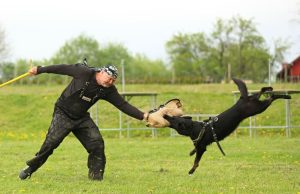Time to Read: 11-12 minutes
Introduction: Setting the Stage for Potty Training Success
Potty training a puppy is often one of the first challenges a new dog owner faces. With the right tools, this process can often be short and sweet. One of my favorite tools in potty training a new puppy is the use of crate training in combination with puppy potty training. In this comprehensive guide, we’ll explore the numerous benefits of using a dog crate in potty training a puppy and how it can contribute to a faster and easier puppy potty training process.
An overview of How to Use Crate Training to aid in Potty Training your Puppy
When you first get your puppy, repeat the following steps as a reliable means of quickly potty training your puppy. First, take your puppy outside, and let the puppy do its thing. Bring the puppy back inside. Then feed the puppy. Since I am a working-line German Shepherd breeder, my dogs rarely suffer from low blood sugar. Therefore, my practice in potty training works better for robust dog breeds. Extra steps will be necessary in order to maintain blood sugar levels in small-breed dogs. In our situation here at Czech Working Line, our focus on GSDs means by the time our puppies go to their forever home, they only need to eat twice a day, three times at the most. So, the steps: Take your puppy outside and let it do its business. Bring your puppy into the house and feed the puppy. Take the puppy back outside after feeding. It is normal for a puppy to need to do its thing soon after eating. Waiting fifteen or twenty minutes can often be too long, and you will end up with an accident in the house. Feed your puppy, and take it back outside. Usually, it will do numbers one and two in fairly short order. Bring your puppy back in the house, let the puppy play or relax for a bit (whether this be 20-30 minutes or an hour), then take your puppy back outside. Allow your puppy to empty its bladder again. Then once it’s safe to go back inside, bring your puppy back into the house and put your puppy in a crate. A key in this process is not to use an oversized crate. A common mistake is to buy an oversized adult dog in preparation for adulthood— I can assure you, the German Shepherd puppies we produce grow like weeds. During the day, alternate your puppy between the crate and time in the house. As soon as you take the puppy out of the crate, immediately take the puppy outside. Be sure to give it enough time to fully evacuate. Then bring the puppy back inside and let it play. Alternate back and forth between time in the crate and time in the house. Always take the puppy outside as soon as the puppy comes out of the crate and then again back outside to go to the bathroom before putting the puppy back into the crate. One important reminder: a young puppy cannot hold its bladder for 8-12 hours like a mature adult. Remember to take your puppy out often, especially when your puppy is young. As the puppy grows, you will gradually be able to space potty breaks to longer and longer time frames.
Creating a Safe Haven: Establishing a Secure Environment
The primary purpose of a dog crate in potty training is to provide a safe and secure environment for the puppy. Dogs are den animals by nature, and a crate simulates a den-like atmosphere where the puppy can feel secure and protected. By confining the puppy to the crate, owners create a designated space where the puppy can rest, sleep, and relax without the risk of injury or harm. This sense of security helps reduce anxiety and stress, creating an ideal environment for successful potty training.
Structure and Routine: Establishing Consistency
Consistency is key in potty training, and a dog crate can help establish a structured routine for the puppy. By confining the puppy to the crate during specific times, such as overnight or when unsupervised, owners can create regular intervals for potty breaks. This routine teaches the puppy when and where it’s appropriate to eliminate, making the training process more predictable and efficient. Over time, the puppy learns to associate the crate with potty breaks, reinforcing desirable elimination habits.
Promoting Bladder Control: Preventing Accidents
One of the most significant benefits of using a dog crate in potty training is its role in promoting bladder control and preventing accidents indoors. Dogs naturally avoid soiling their sleeping area, making the crate an effective tool for encouraging appropriate elimination behavior. When properly sized, the crate provides enough space for the puppy to stand up, turn around, and lie down comfortably without encouraging them to eliminate inside. This encourages the puppy to hold their bladder until they are let out of the crate and taken to the designated potty area.
Supervision Made Easy: Minimizing Opportunities for Accidents
Supervising a puppy constantly can be challenging, especially during the early stages of potty training. However, a dog crate offers a practical solution by providing a safe and confined space where the puppy can stay when unsupervised. This minimizes the risk of accidents and unwanted behaviors indoors, such as chewing or soiling carpets. By confining the puppy to the crate when unable to supervise closely, owners can prevent accidents and maintain a clean and hygienic living environment.
Expediting the Learning Process: Accelerating Potty Training Success
Using a dog crate in potty training can expedite the learning process and accelerate the puppy’s understanding of appropriate elimination habits. By confining the puppy to the crate during periods of inactivity or overnight, owners can effectively limit the opportunities for accidents indoors. This encourages the puppy to learn to hold their bladder and develop the habit of waiting to be taken outside for potty breaks. With consistent use of the crate, many puppies quickly learn to associate the crate with relaxation, making it easier to establish a reliable routine for potty training.
Building Positive Associations: Introducing Crate Training Gradually
Introducing crate training gradually and positively is essential for success. For many puppies, the crate may initially be perceived as a foreign or intimidating environment. To ensure a positive association with the crate, owners should introduce it gradually, using treats, toys, and praise to create a positive association. Start by allowing the puppy to explore the crate at their own pace, gradually increasing the duration of confinement over time. With patience and positive reinforcement, most puppies learn to view the crate as a safe and comfortable space.
Practical Tips for Using a Dog Crate in Potty Training
– Choose the Right Size Crate: Select a crate that is large enough for the puppy to stand up, turn around, and lie down comfortably, but not so large that they can eliminate in one corner and sleep in another.
– Establish a Routine: Stick to a consistent schedule for feeding, potty breaks, and crate time to help the puppy develop a routine and predict when they need to eliminate.
– Use Positive Reinforcement: Reward the puppy with treats, praise, and affection when they eliminate in the designated potty area and exhibit desirable behaviors.
– Supervise and Monitor: Keep a close eye on the puppy when they are out of the crate, and be vigilant for signs that they need to eliminate, such as sniffing, circling, or whining.
– Be Patient and Persistent: Potty training takes time and patience, so be prepared to be consistent with your efforts and provide plenty of encouragement and support along the way.
Conclusion: A Valuable Tool for Potty Training Success
In conclusion, using a dog crate in potty training offers numerous benefits for both puppies and their owners. From establishing a safe and secure environment to promoting bladder control and preventing accidents indoors, the crate plays a pivotal role in accelerating the potty training process and fostering desirable elimination habits. By incorporating crate training into their routine and following practical tips for success, owners can set their puppies up for potty training success and lay the foundation for a lifetime of good behavior. Whether you found a great puppy somewhere else or if you are still looking for a working line German Shepherd puppy for sale, feel free to reach out by phone, email or text. We specialize in IGP 1, IGP 2, and IGP 3, Schutzhund titled working line German Shepherd stud dogs. Our dogs are good for both home protection as well as something more serious. In any way we can help you, we’d love to hear from you.
Sources:
1. Burch, Mary R., and Jon S. Bailey. *How to Crate Train Your Dog.* Wiley, 2000. [Link](https://www.amazon.com/How-Crate-Train-Your-Dog/dp/0764553028)
2. Yin, Sophia A. *Perfect Puppy in 7 Days: How to Start Your Puppy off Right.* CattleDog Publishing, 2011. [Link](https://www.amazon.com/Perfect-Puppy-Days-Start-Right/dp/0964151871)
3. The Humane Society of the United States. “Crate Training 101.” [Link](https://www.humanesociety.org/resources/crate-training-101)
4. Wright, John C., et al. “Effectiveness of dog training with and without remote electronic collars vs. a focus on positive reinforcement.” Frontiers in Veterinary Science 7 (2020): 590300. [Link](https://www.frontiersin.org/articles/10.3389/fvets.2020.590300/full)
5. Rooney, Nicola J., and Sarah DF Heath. “Behavioural biology of the domestic dog.” CAB Reviews: Perspectives in Agriculture, Veterinary Science, Nutrition and Natural Resources 4.66 (2009): 1-10. [Link](https://www.cabdirect.org/cabdirect/abstract/20103191708)




